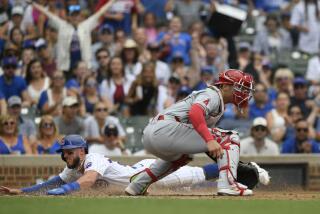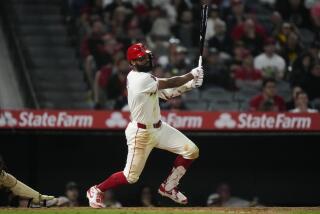Anderson Keeps Angels Well-Armed
- Share via
Every time I pick up the paper of late, it seems someone is about to trade the Angels’ Garret Anderson.
Why?
You’d figure he was some kind of major disappointment instead of one-third of what may be the best outfield in baseball.
You hear his name in connection with a deal to acquire Mark McGwire, a deal for a left-handed pitcher, a deal for Roger Clemens or a deal for just about anybody who’s about to become a free agent.
It isn’t as if Anderson is an automatic out or a liability in the field. It isn’t as if he’s about to be caught mainlining or breaking a law or two as some of his outfield contemporaries have. Anderson’s habits are as steady as a banker’s, he’s a tough out, a steadying influence and a team player.
And he’s a marvelous fielder, which is more than you can say for some of the packages he’s rumored to be traded for.
At the close of business Tuesday, Anderson had 14 assists. It’s a stat they don’t even list in the box scores anymore but it always has been a measure of an outfielder’s efficiency.
You look down the list of Hall of Fame outfielders and you find the great ones excelled at throwing out runners. Roberto Clemente, the greatest right fielder most of us ever saw, led the league in assists five times. I once saw Clemente throw out Sandy Koufax at first base on a single to right. (Of course, Sandy was so surprised he stood there for a minute looking around to see who did it.)
The great Hall of Famer Tris Speaker was the whole book on assist-making. He leads the major leagues in lifetime outfield assists with 448. But the famous “Grey Eagle’s” trick was to play a very shallow center field. He had great speed, which enabled him to go back for the long ones. In that beanbag-ball era, the ballparks weren’t that big or the fences so far back. So, the great Spoke usually had a makable throw to every base and almost nobody went from first to third on a hit to him.
It’s probably the reason the Phillies’ Chuck Klein is the National League season assist leader with 44. Klein was a right fielder in Philadelphia’s Baker Bowl, where the tin right-field fence was only a little over 250 feet away. He played shallow because he had to. The fence was shallow.
It also may have played a part in Carl Yastrzemski’s leading the league seven times in assists. Yaz played in front of Fenway Park’s “Green Monster” left-field fence, only 314 feet from home plate.
Willie Mays was the opposite. He played half his career in the old Polo Grounds, where the center-field fence was a cab ride (480 feet) from home plate. It was there he made probably the most famous catch in World Series history, a line drive off the bat of Cleveland’s Vic Wertz, 460 feet from home plate. Then, he whirled and threw to second, forcing Al Rosen to retreat to first.
Management and fans alike frequently overlook the importance of outfielding precocity. They look to hitters. But a study of the game shows batting prowess can fade by comparison. Old-timers have told me an outfielder-infielder named Dale Alexander might have been one of the five best hitters in the game in his time (the 1930s). He hit .331 lifetime and led the American League in hitting in 1932 with a .367 average. Yet, two years later, he was out of baseball. Why? He was a butcher in the field, making 71 errors in a little more than three years. Ditto Smead Jolley. Hit .305 lifetime. Had the range of a penguin in left field.
So, it would behoove the Angels, it seems to me, to realize what they have in Anderson and take him out of the window, remove the “For Sale Or Make Offer” sign and lock him into a no-cut or trade contract.
Garret is this kind of a player: He had a sore arm for over a year and didn’t tell anybody. The league didn’t know it, the team didn’t know it, only Anderson did. “I messed up a biceps tendon,” he says. “It messed up my throws pretty bad.”
What he did was, “I played deeper and I charged balls hit to me.” That way, he could shorten (and speed up) his relays to the infield.
“I could hit the cutoff man,” he says. “I was at pains to keep the [other team’s] coaches from knowing I was hurt. So, they wouldn’t know to challenge me on the bases.”
It was a superb deception. Now that Anderson’s arm is 100%, he has thrown out 14 runners trying to take an extra base this year, second in the league (to Detroit’s Bobby Higgenson).
It’s not that Anderson is just a glove, either. He was hitting .302 with 77 RBIs, second on the team, through Tuesday. He was second on the team in doubles (27) and first in hits (153).
His manager is well aware. Says Terry Collins: “He’s an up-and-coming great star of the game. He does things easily. He’s not greedy up there. He’ll take a base hit, he won’t try to hit every ball out of the park. I can easily see him not only hitting .300, but also hitting 20-25 home runs. And, he’s only 25 and a student of the pitching.”
So, the Angel dugout knows what they have. But how does he feel about the front office floating rumors of trades? “There’s a flip side to it,” he grins. “It means somebody wants me.”
Exactly. Willie Mays saved many a pitcher’s reputation with his glove. So can Garret Anderson. You need an armed man out there to keep order. Anderson is the Angels’ frontier marshal.
More to Read
Go beyond the scoreboard
Get the latest on L.A.'s teams in the daily Sports Report newsletter.
You may occasionally receive promotional content from the Los Angeles Times.






